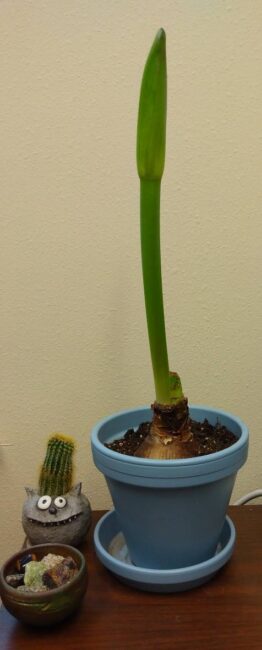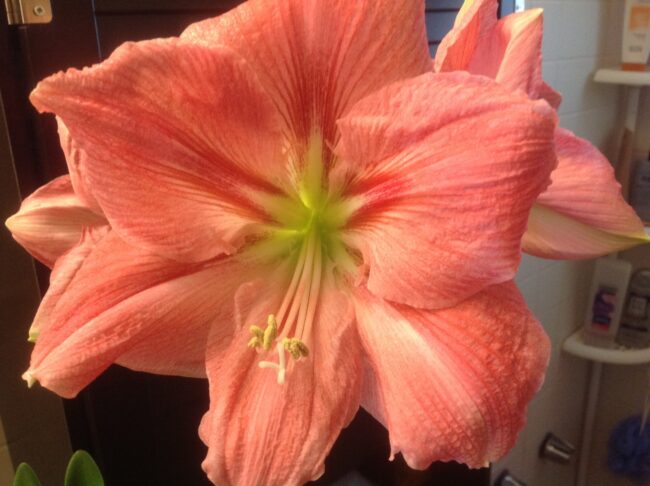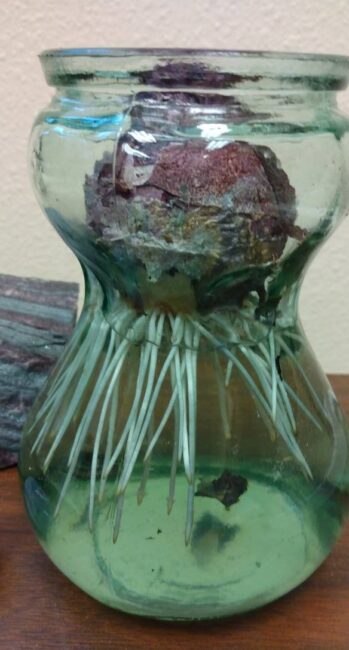You may have received or purchased some flower bulbs over the holidays. For forcing, you need to know whether you have a precooled or non-pre-cooled bulb. Or maybe you have an amaryllis bulb, which needs no cooling due to its tropical origins.

Amaryllis bulbs produce large showy blooms on a sturdy stalk. The common name ‘Amaryllis’ is something of a misnomer; true amaryllis or belladonna lilies are from South Africa. The correct botanical name of the bulbs we are talking about is Hippeastrum; they are native to South America. However, garden centers sell them as amaryllis, so that is what you should ask for if shopping for them. They are usually sold as large dormant bulbs, often packaged in a planting kit.

If the bulb is un-potted, purchase a 6-8” diameter pot about 1-1 ½ inches in diameter larger than the bulb diameter for best blooming. The pot should not be excessively deep. Use a well-drained houseplant mix that doesn’t contain pine bark, and plant the bulb so about one third to one-half of the bulb protrudes above the soil line. The soil line should be about 1 inch below the pot rim to serve as a water reservoir when watering. If roots are tangled, try to gently spread them a bit; they are brittle, so be very careful. Make sure there are no air pockets around the roots as best as possible. Gently firm soil around the bulb, then water. Grow in a bright area, ideally between 65-70°F while the flower stalk is growing. If the temperature is too high, a weak flower stalk and smaller flower may result. Keep the soil somewhat moist, but don’t overwater. Two to six big, beautiful white, red, salmon, or pink flowers are produced on a stalk that may be 18-24” tall. You can extend the bloom by taking the plant out of direct sun and placing it in a cooler room—about 60-65°F. Remove each faded flower without damaging the main stem. When the main stem droops and starts to brown, cut it off a couple of inches above the bulb neck. After removing the main flower stem, when leaves are starting to be produced, you can fertilize once a month with a 5-10-10 or 10-10-10 fertilizer at the rate directed for houseplant. After flowering, move it back to a sunny warm window or outside for summer, once the danger of frost has passed. Keep watered and fertilized while leaves are actively growing—this produces energy for next year’s flower. If you put the plant outside for summer, you can keep it on a porch or deck or sink the pot into the ground in an area with part shade or morning sun. Watch that it doesn’t get too dry. Bring it back inside before frost. In September or October typically, leaves will die back and bulbs will go dormant. Remove brown, dried leaves and store the potted plant in a cool, dry place. Keep the bulb on the dry side but don’t let it completely dry out while dormant. Hippeastrum bulbs require 8-10 weeks of dormancy in order to initiate flowers. In late November or December, growth will begin again, and you can look forward to another set of beautiful long-lasting flowers!
Pre-cooled bulbs have already met the chilling requirements that they need in order to bloom and grow, courtesy of the wholesaler or retail vendor. Pre-cooled bulbs save a lot of time and refrigerator space, but you can usually only get a few species. Pre-cooled paperwhite narcissus and hyacinth bulbs will root into water if suspended just above the surface of the water. Once rooted, they should produce flowers and leaves. Many garden centers sell vases that are designed just for these types of bulbs, or you can plant the bulbs in potting soil. Bulbs grown without potting mix in water use up their energy resources and often won’t bloom again, even in the garden, so they are best discarded after blooming.

Spring bulbs that have not been pre-cooled, normally planted in fall, such as tulips, daffodils, crocus and hyacinth will need to be ‘forced’ to bloom in early spring by putting them in an artificially cold, moist and dark environment like a refrigerator at 35-38°F. Pot bulbs up prior to refrigeration, water them in and keep moist but not wet for best results. Don’t plant them too deep in the potting mix. For larger bulbs, two to three inches deep is fine, for small bulbs, about an inch deep is sufficient. Be sure not to store fruit (especially apples) in the refrigerator while forcing bulbs. Ethylene gas released from the ripening fruit impairs flower development of the bulbs, so they may not bloom or may have distorted flowers. Some species naturally bloom later than others. Even different cultivars (named varieties) within the same species (such as crocus species and/or varieties), have late or midseason spring bloomers as opposed to early spring. Check the bulb variety description (early, mid- or late season) on the packaging; this should give you an idea of whether they will need more or less chilling within the range for that species. When the cold period is complete (see table below), bulbs should have one to two-inch-tall shoots that initially will be white, but will turn green once exposed to sunlight. Bring sprouted bulbs out of refrigeration into a sunny spot where the temperature is between 55 and 60ºF. Keep the plants watered and fertilized like a normal houseplant until you can plant them outside in spring after threat of frost has passed. Allow the foliage to die back naturally. The bulbs may bloom the following spring, but may need a year of leaf growth before they bloom again. Forced hybrid tulips often will not come back at all, especially in heavier clay soils. The short, so-called ‘species’ tulips are longer-lived.
The following table is from the Virginia Cooperative Extension publication HORT-76NP-Fooling Mother Nature: Forcing Flower Bulbs for Indoor Bloom. Note: These times do not apply to pre-cooled bulbs. They apply to uncooled bulbs only. For pre-cooled bulbs you only need to pay attention to the fourth column of the table in estimating time to bloom.
| Table 2: Bulb Times for Forcing | |||
| Common Name | Scientific Name | Cooling Time (weeks) | Weeks to Bloom After Cooling |
| Amaryllis | Hippeastrum spp. | None | 6-8* |
| Dutch Crocus | Crocus spp. | 12-14 | 2-3 |
| Daffodil | Narcissus spp. | 13-15 | 3-4 |
| Checkered Lily | Fritillaria meleagris | 15 | 3 |
| Glory of the Snow | Chinodoxa luciliae | 15 | 2-3 |
| Grape Hyacinth | Msucari armeniacum | 14-15 | 2-3 |
| Dutch Hyacinth | Hyacinthus orientalis | 10-13 | 2-3 |
| Bulbous Iris ** | Iris reticulata | 15 | 2-3 |
| Paper White Narcissus | Narcissus tazetta | None | 5-6 |
| Siberian Squill | Scilla siberica | 15 | 2-3 |
| Snowdrop | Galanthus nivalis | 15 | 2 |
| Tulip | Tulipa spp. | 14-20 | 2-3 |
| Winter Aconite | Eranthis hyemalis | 15 | 2 |
*Often, they will bloom within 4 weeks, I have noticed. If your room is cooler, it may take longer.
** Also called reticulate or netted iris
For more information, visit the Wisconsin Horticulture webpage for a fact sheet at https://hort.extension.wisc.edu/articles/forcing-bulbs-2/ .




